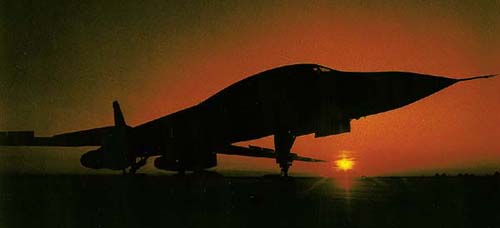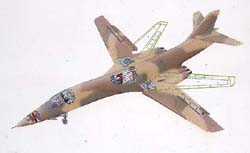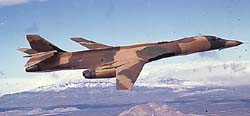

Controversial is always the first word in a story about the B-1 bomber. Some call it the defender of the future. Some insist it is doomed to failure as a military aircraft. The Defense Department pictures it as a limited-production interim bomber between the B-52 and the upcoming Advanced Technology Bomber (ATB). Despite the constant barrage of news stories on the B-1, the public has never taken a look at the insides of this amazing high-technology bomber, largely because the discussion has taken place in the halls of Congress rather than on the runway tarmac.
To take a flight in the B-1 is to enter a world of roller-coaster maneuvers and split-second decisions. The tops of trees rush by at 600 mph, a green peripheral blur. The valley floor lies 200 ft. below. A range of hills fills the horizon ahead. You're flying low and fast, penetrating enemy territory. Electronic sensors "see" the hills, and move the controls to fly you safely through a gap below the peaks. The big bomber banks between menacing rocky ledges and outcroppings, and eases down into the valley below, using terrain features to mask itself from enemy radar. Air currents rising off the uneven land would buffet a lesser plane. The B-1B has ride control: horizontal forward vanes and a rudder segment to sense rough air. An automatic control system compensates for every bump with lightning-fast responses.
Behind you and your copilot, the two operators of the electronic warfare system blind and deafen enemy communications, and deceive interceptors with false targets.
The B-1B is the long-range penetrating derivative of the original B-1 design. It can launch attack and cruise missiles, drop conventional bombs, lay mines, patrol the seas, and hunt and kill submarines. It's smaller than the B-52 it will supplement (see B-52: Holding The Fort), but almost as heavy. And it requires four crewmen instead of the B-52's six.

B-1B has sophisticated navigational radar and advanced electronics, and the wings sweep back for combat flight. Illustration by George Retseck.
It's also expensive: the 100 production airplanes represent research, development, test, design and production investments of $205 million each. Critics think the B-1B will be detected and destroyed easily by tomorrow's defense systems. Others question the need for a manned bomber mission. Some want to bypass the B-1B in favor of Northrop's ATB with the latest stealth techniques. Northrop's ATB is in the testing phase now.
The B-1B's most conspicuous feature is its variable-geometry (VG) wing, blended into the fuselage for best aerodynamic performance. Its outer panels are pivoted on huge titanium alloy pins, nearly 20-in. in diameter. For takeoff, climb, cruise and landing, the wing sweeps forward to 15� of sweep-back angle. For low-level, high-subsonic speeds, and supersonic flights, the wings sweep to their 67� maximum. The wing design is responsible for reducing takeoff distance and time dramatically, compared to the B-52.
Added low-speed lift comes from 7-segment, full-span leading edge slats, deflecting 20� for takeoff and landing to direct airflow over the wing at the high angles of attack of slow flight. The trailing edge carries 6-segment, single-slotted flaps, their maximum deflection of 40� adding lift for landing. There are no ailerons; four-segment airbrakes and spoilers provide lateral control.
The four General Electric F101-GE-102 augmented turbofans deliver more than 30,000 pounds of thrust each. Developed over 14 years, they have been tested the equivalent of 10 years' service in the B-1B.
JP-4 fuel is stored in eight integral tanks, six in the fuselage and one in each outer wing panel. The two main tanks are in the massive titanium-alloy carry-through structure. Additional fuel for long-range flight can be carried in weapons-bay tanks, and there is provision for six under-wing pylon-mounted drop tanks. A fuel management system automatically balances the airplane as the wings sweep by pumping fuel between the tanks and always maintaining full main tanks. Unrefueled range is approximately 7500 miles, and the B-1B can be refueled from either the Boeing KC-135A or the McDonnell Douglas KC-10A airborne tankers. Powerplant inlet design masks the engine faces to reduce radar reflections. That concept, one of the uses of stealth techniques in the B-1B, plus antiradar coatings, has made the radar cross section 1/100th that of the B-52.
The B-1B can load 125,000 pounds of weaponry in three bays: Long- and short-range air-to-surface nuclear-warhead missiles such as 24 SRAM (short range attack missiles), or free-fall bombs, either nuclear or conventional (up to 84 Mk. 82 iron bombs, for example). Also, 14 cruise missiles can be carried on belly stations.
The B-1B is crammed with the black boxes of modular, self-checking offensive and defensive avionics systems, each system operated by a single crew member. The Boeing offensive avionics system--providing navigational information, and data for alignment and launching of weapons--includes terrain-following, Doppler, and altimeter radars and a highly accurate inertial navigation system. Defensive electronics are built around the AIL/Eaton ALQ-161 electronic countermeasures system, more than 100 boxes and antenna weighing more than 2-1/2 tons. Zoned to detect enemy signals from any point, they respond automatically with electronic deception, chaff and flares. Avionics, electrical equipment and wiring are shielded from the destructive effects of electromagnetic radiation from nuclear weapons detonations.
Transparent ceramic cockpit panels and portholes, made of a new material with the jaw-breaking name of polarized lead lanthanum zirconate titanite (PLZT), are capable of turning opaque within microseconds in response to intense light. They protect the crew from being blinded by the flash of nuclear weapons detonations.
There were mavericks. Northrop's YB-49 (1947) was an all-wing jet-powered bomber eliminated by stability problems. The General Dynamics B-58 (1956), a supersonic delta-winged speedster, served in limited numbers until the realization that its high-speed, high-altitude attack would not save it from enemy surface-to-air missiles.

Combat-ready B-1B began service this year. It will serve along with the B-52, which was first produced in the 1950s.
More radical was North American's XB-70 (1964), with its delta wing and forward canard. Planned for searing supersonic flight in the stratosphere, the XB-70 also would have been an exceptionally large missile target.
Both B-52 and FB-111 suffer from frequent failures of major systems, and have disappointing readiness records. If the whistle blew, they'd go, but performance could be below par.
The B-1B began with a 1962 Air Force study and concepts by Boeing, General Dynamics and (then) North American for a bomber for the mid-1970s. It was to fly faster than Mach 2 at altitudes of 70,000 ft., carry more bombs than the B-52 and have comparable unrefueled range.
The Air Force contracted with North American Rockwell on June 5, 1970, for five B-1 prototypes for flight test and two for ground tests of structures, and with General Electric for 40 F101 engines. Projected B-1 flyaway cost: $25 million each, with an expected production run of 240 bombers.
The designers adapted the blended wing-body shape developed for their F-15 proposal, chose a VG wing, included a soft ride system for low-level penetration and froze the outlines in January 1971. Four months later came the first brickbat: a congressional recommendation to terminate the program, on the grounds of underestimated costs, vulnerability to advanced enemy air defenses, and whether there would be a manned bomber mission after 1980.
Late in June 1977, President Jimmy Carter cancelled production of the B-1, but continued funding for developmental flight testing. By then, estimated cost of each bomber was $100 million.
More changes followed. The B-1B flies at Mach 1.2, about half the former target of Mach 2.2 to 2.3. Stronger landing gear compensates for a higher operating weight. About 70 percent of its airframe is in common with the B-1. Advanced technology makes its avionics 80 percent different, with all new offensive and defensive systems.
B-1B testing began March 23, 1983, with the flight of the second B-1 prototype, now incorporating some B-1B features. In August 1984, it was destroyed in a crash.
The first production B-1B was rolled out Sept. 4, 1984, from Rockwell's huge assembly plant at Palmdale, Calif. It was five months ahead of the latest schedule, and within budget. It first flew on Oct. 18, 1984, and is on flight-test status. Deliveries to the Strategic Air Command began last June. The first 15 of an eventual complement of 26 B-1B's go to SAC'S 96th Bomb Wing at Dyess AFB, near Abilene, Texas.
Subsequent deliveries, building to a maximum rate of four a month, will be made to SAC bomb wings at Ellsworth AFB, South Dakota (32 aircraft); Grand Forks AFB, North Dakota; and McConnell AFB, Kansas (16 aircraft each). The final plane will be delivered in 1988.
As you read this, the 96th Bomb Wing will be about one year away from its Initial Operational Capability (IOC), a milestone once scheduled to be passed in 1974.
Possibly the arguments will continue to rage. After all, whether the B-1B is a superbomber or a bummer can only be answered in the lethal circumstances nobody wants: War.

B-52: Holding The FortEarly in the Vietnam War the 10-year-old B-52 Stratofortress was slated to become obsolete. It would be replaced by the B-58 Hustler, a high-tech bomber that could outrun anything the enemy could throw at it. Except missiles. The B-58 never got off the ground, and the B-52 became the mainstay of the Vietnam air war. Now that B-1B's are coming on line, the Air Force is hedging its bets with the B-52. The old standby will continue in service probably into the 1990s or beyond. The Strategic Air Command has almost 270 B-52s in service. The latest model B-52s (B-52G and B-52H) can perform a wide variety of functions at speeds over Mach .5 and altitudes above 55,000 ft. The B-52 can fly under radar and above most anti-aircraft weapons. The G model can carry cruise missiles, while the H model carries a variety of conventional and nuclear bombs. The biggest trouble with the B-52 is it puts out a large radar signature. But, so far, no aircraft has come along that could be called truly stealthy. So the B-52 continues to hold the fort. --D.E.
|